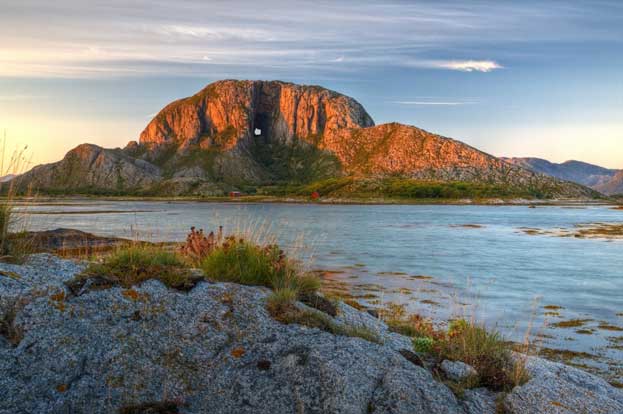The Vega Archipelago reflects the way generations of fishermen/farmers have, over the past 1,500 years, maintained a sustainable living in an inhospitable seascape near the Arctic Circle, based on the now unique practice of eider-down harvesting, and it also celebrates the contribution made by women to the eider-down process. The site is the major part of the Vega archipelago, a seascape made up of more than 6,500 islands, islets and 'skerries', and surrounding shallow water. It is an exposed landscape of sea and land, with many low, almost treeless islands dotting the surface of the sea against a backdrop of dramatic coastal mountains. Over 50 islands are, or were, inhabited, many seasonally.

Continent: Europe
Country: Norway
Category: Cultural
Criterion: (V)
Date of Inscription: 2004
The Vega seascape
The seascape is centred on Vega, the largest island, 10 km from the mainland. The unique geology forms the raw material for settlement and livelihood. This archipelago is part of a 'strand flat' formation, a wave-cut platform providing a broad area of shallow sea punctuated by low islands and the mainland fjords. The archipelago shares characteristics with Norway's northern Atlantic coast, but its cultural landscape is more intense and better preserved than elsewhere. The Vega seascape contains fishing villages, quays, warehouses, 'eider' houses, the farming landscape and navigation buildings such as lighthouses and beacons. The site reflects the following cultural qualities.Historical depth: There is extensive evidence for early Stone Age habitations. More than 100 sites, some with visible houses, have been discovered on the lower slopes of Vega Mountain, but this is thought to be a tiny percentage of the total. The largest settlement site is Asgården, with the safest harbour and where many artefacts have been recovered. Smaller settlements probably functioned as hunting sites. The earlier sites on Vega were abandoned as people moved to lower ground, where there is a continuity of settlement to the present day, and a continuity of livelihood, with finds associated with farming, fishing and collecting down. Finds include house mounds, field clearance cairns, harbours, barrows and 'eider' houses.
 |
| The Vega Archipelago |
Browse Gallery Plus UNESCO Storyline
Distinctive settlement patterns: The strand flat formation has allowed agriculture to develop on a small scale on the islands. Fields were formed by building up suitable soil through mulching with seaweed. The traditional pattern of 'infields' and 'outfields' can still be clearly seen. Beyond the fields, varieties of heath have developed through prolonged grazing (by sheep and cattle), scything and burning, and much of the diverse heathland vegetation is now related to these processes. Of the 56 islands that have been inhabited, some had only one house whereas others, such as Skjævær and Vega, had larger settlements. Many of the houses were used only seasonally, for fishing or down gathering. The local building material was wood. In the extreme climate, buildings had a limited lifespan: no surviving buildings are older than 100-200 years. Many dwellings survive, unlike buildings related to the fishing and farming processes.
Specialized occupations down collecting and fishing: the harvesting of down (the soft feathers from the nests of eider ducks, which breed in large numbers on the islands) is the most distinctive occupation. Eider duck were encouraged to nest year after year on the same sites in nesting houses built from either stone or wood and lined with seaweed to simulate natural nesting sites under crags on the shore.
There is archaeological evidence for the harvesting of birds from the time of the earliest settlements, and archival evidence from Egil's Saga, written down in the 11th century. Eggs were collected for domestic use. The nesting houses attracted the birds and provided shelter from predators. The fishing and hunting of marine animals has taken place since the ice retreated around 10,000 years ago.
The type of fishing varied throughout the year. Today there are very few active fishermen compared to their numbers 100 years ago. Remains of this fishing tradition are seen in quays, breakwaters, warehouses and boathouses, as well as the Bremstein lighthouse. The tradition of boat-building dates back to Viking times and is still maintained.
Cultural traditions: The oral traditions of the islands relate to the traditions of fishing, farming and down harvesting, and are significant in connection with place-names, landmarks for fishermen, rituals, folk medicine and local superstitions, including spirits to be propitiated for successful fishing or farming, and those that foretold death and disaster.
Browse All UNESCO World Heritage Sites in
Norway. The original UNESCO inscription
Here!!!












0 comments:
Post a Comment